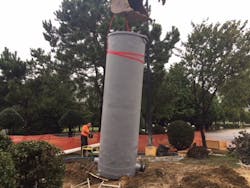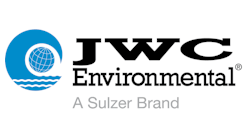Elizabeth Quigley is industrial sales manager for JWC Environmental. Elizabeth can be reached at [email protected].
Wastewater treatment plant operators have dealt with clogging problems at their plants and pump stations for decades, but the meteoric rise in the use of disposable wipes and other non-dispersible products has accelerated the problem to epidemic proportions.
When paper towels, cleaning cloths, baby wipes, feminine hygiene products and cosmetic wipes are flushed down the toilet, they ultimately reach influent pump stations at wastewater treatment plants relatively intact – clogging and jamming pumps, check valves and screens, and significantly increasing maintenance, repair and operational costs. Wet wipe consumption overall has nearly tripled in the past decade and continues to grow.
This problem is in no way limited to municipal wastewater treatment facilities. The growing volume of non-dispersible solids is just as much a serious and growing issue for commercial operations, such as healthcare facilities, multi-family developments, high-traffic convenience stores, and big box retailers. Many of these facilities maintain on-site pump lift stations, which are the first to be impacted by this non-dispersible debris.
Big Box Dilemma
The on-site pump stations that handle wastewater effluent from big box stores, and particularly those selling apparel, must also deal with a significant volume of product packaging, security tags and clothing that is flushed down restroom toilets as a result of theft. Consequently, these pump stations more frequently become severely impacted, necessitating a high volume of costly emergency repairs, and increased municipality fees for discharging debris into sewer lines.
“Just about any company that has a lift station runs into non-dispersible debris as a problem,” said Wade Stafford, vice president wastewater services at Aqualis, a national, full-service maintenance and construction company that provides services for a wide variety of commercial businesses including retailers, shopping centers, fuel stations and restaurants. “We have found that these retail sites, however, experience a higher level of damage to pumps, compared to other industries, simply because of the amount of harder solids or elastic-based clothing that gets flushed down the toilet.”
“A correctly-maintained maintenance program can curb the problem, which helps to keep the pumps functioning and forecast damage,” added Stafford. “But emergency response for repairs to these pump stations caused by the impact of non-dispersibles is inevitable, and can approximate $30,000 annually.”
Servicing one of the world’s leading retailers, Aqualis was tasked with finding alternative solutions to the non-dispersibles problem.
“Our customer is very much on the forefront of leveraging technology to make their business better, and more cost effective,” continued Stafford. “So we looked at many different technologies that were available for improving the performance of our client’s lift stations regarding the handling of these effluent solids, thoroughly researching and vetting them.”
Ultimately, Aqualis settled on the Monster Industrial Manhole from JWC Environmental, a manufacturer of waste shredders and screening systems that help municipal facilities and industrial companies solve challenging waste reduction and recycling applications
Monster Industrial Manhole
The Monster Industrial Manhole is a pre-fabricated sewer manhole with a grinder, which is fully assembled and ready to install. This fiberglass manhole is an excellent solution when a sewage grinder is needed but there is not enough room for conventional installations.
“It grinds up trash, wipes and other non-dispersible waste in the sewage before it enters the municipal wastewater system, providing complete sewer pump protection and eliminating costly pump breakdowns,” said Thomas Smith, director of industrial sales at JWC Environmental. “A built-in grit trap prevents grit from reaching the grinder, extending cutter life.”
Designed to fit almost anywhere, the four-foot diameter prefabricated, fiberglass-reinforced polyester manhole sewage grinder system is customizable to fit exact site requirements, such as depth, inlet and outlet pipe diameters, it also includes the option of a hatch or flat cover. A factory-installed guide frame and ladder make it easy to access the grinder.
“The manhole is simple to install, by digging down to the sewer line, creating a concrete pad for the fiberglass manhole unit to rest on, then tying it in the sewer lines,” added Smith. “The prepackaged system avoids costly civil construction work, and is easy to maintain, requiring only semi-annual inspections.”
Dual-Shafted Grinder
At the heart of the Monster Industrial Manhole is a JWCE 3-Hydro, dual-shafted, open-channel, immersible-motor grinder that can handle much larger debris than the lift pumps. Two stacks of sharp, hardened-steel cutters rotate slowly with high torque, easily grinding large solids into small particles. Side rails within the grinder are designed to more effectively drive debris into the cutters. Integrated steel scrapers help the cutters clean out quickly to maintain throughput. The grinder can handle flows from 370 to 5,620 gpm.
“Dual-shafted grinders, such as the JWCE 3-Hydro, are better designed for cutting effluent material down to size, more efficiently than single-shafted machines and macerators,” explained Smith. “These grinders integrate strong shafts and heavy-duty mechanical seals, allowing for high-impact solids loading.”
Wipes Ready Cutter Technology
The Monster Industrial Manhole grinder also uses JWCE’s patent-pending Wipes Ready technology, which is designed to shred rags, wipes, diapers, clothing and other disposable, non-dispersible items that commonly clog sewage pumps, into small enough pieces so they will not reweave into ragballs in sewage systems.
“While conventional grinders make long strips out of wipes that reweave into ropes, the Wipes Ready technology uses serrated tips that puncture and tear at the fibers, leaving small pieces that stay in suspension, and are easier to handle by traditional sewage pumps,” continued Smith. “This optimized cut control prevents build-up, keeps the cutters clean, and maintains high flow. The smaller pieces are then removed at the headworks of wastewater treatment facilities.”
Remote Telemetry
The components of the Monster Industrial Manhole are controlled with a PLC, with sensor monitoring through remote telemetry via the cloud. Faults in the pump such as vibration or high amperage overload, high water levels in the manhole, and many other faults can be displayed on human machine interface (HMI) at a remote location.
“Remote telemetry permits us to dial into exactly what is going on with the pump station in real time,” Stafford said. “We can see what is happening many times before the fault turns into a major situation, and take steps to resolve it, such as before there is an overflow into the parking lot, or a backup of sewage into the facility.”
Aqualis records these metrics and maintains a historical database for each Monster Industrial Manhole, encompassing any type of damages, manhole condition, pump condition and component condition, and factors this data with its preventative maintenance programs. Such a comprehensive approach saves on costly emergency service calls and mitigates equipment damage.
Aqualis installation of the first two Monster Industrial Manholes with one of its big box customers, completed in mid-2017, has produced significant ROI. One facility in Madison, Indiana, with a three-year average annual repair cost of $30,600 prior to installation of the Monster Industrial Manhole, has now accrued $0 annually in repairs after more than 18 months in operation.
A second Big Box Location in Newport News, Virginia, with a three-year average annual repair cost of $68,300 per year prior to installation of the Monster Industrial Manhole, has also now accrued $0 in repairs after more than 18 months in operation.
“The emergency services at these locations have basically stopped completely,” Stafford said. “Our customer is very happy with the solution we put into place, because they are not having to pay costs above and beyond normal preventative maintenance.”
Smith noted the success was a team effort between Aqualis and JWCE.
“Aqualis came to us looking for a solution to a customer’s problem. We worked together to address their needs and come up with a workable solution," Smith said.
Stafford added that the long-term success has proved to him and his team how valuable the technology can be for utilities and industrial facilities throughout the country.
“Instead of replacing pumps, we have effectively surmounted the problem and are now able to ensure our customer’s equipment will have considerably more longevity," Stafford said. "JWCE was instrumental, not only in their product offerings, but also the support and customization they were able to bring to the table.”


